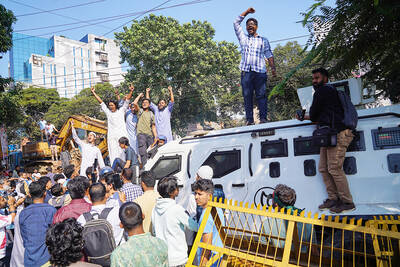Sixty years ago Maurice Kriegel-Valrimont was moving from safe-house to safe-house in German-occupied Paris, masterminding the popular insurrection that was to go down in national legend as the moment France won back its lost military honor.
On Aug. 25, 1944, he was there in the billiards-room of the Prefecture de Police when the capital's military governor Dietrich von Choltitz signed the surrender document, and he was on the half-track which then carried the humiliated general on a triumphant procession through the newly-liberated city.
A famous photograph shows the vehicle moving through ecstatic crowds on the its way to Montparnasse station. General Philippe Leclerc, commander of the French armored division that had just entered Paris, has his back to a bowed and dejected von Choltitz.
Bespectacled and in civilian clothes, Kriegel-Valrimont stands to the rear: the hidden theoretician of revolt who has finally thrown off the cloak of clandestinity to assume his place in history.
Now aged 90 and living in rural Burgundy, he is the last surviving player from one of the key moments of World War II: his mission still today, as a faithful man of the left, to emphasize the role of the anonymous masses in ending four years of Nazi occupation.
"In Paris we had a great advantage -- which was a tradition of popular uprising. There was the revolution of course in 1789, but after that 1830, 1848, above all the Commune in 1870. There was a body of doctrine. We knew how to do it," he recalled in an interview.
"On top of that we had all studied military theory -- Clausewitz and others -- and had a good grasp of when to act: not too early and not too late. I myself had no military training, but I had become an expert," he said.
By mid-August 1944, the writing was on the wall for the army that had marched victoriously into the French capital four years earlier. After the Normandy landings in June, the Allies were sweeping in from the west, and German troops were being withdrawn from Paris to put up a defense elsewhere.
As one of three members of the Military Action Committee (COMAC) of the National Resistance Council (CNR), Kriegel-Valrimont organized a series of strikes. He wrote the inflammatory texts that appeared overnight on fly-posters and underground news-sheets. Then Free French radio began broadcasting, and on Aug. 22 the barricades appeared.
"In 36 hours there were 600 or more. The people were like ants -- tens of thousands of them. Some of the barricades were real masterpieces, built by craftsmen and strong enough to stop a tank. Others would have just collapsed, but the Germans didn't know which was which."
"First fear had changed sides, and now the initiative changed sides too. The Germans were the ones forced onto the defensive, and they fell back on just a dozen centers of operation," he said.
Hundreds of Frenchmen died in the fighting, and their names can still be seen on memorial plaques across the capital which are decorated with flowers every anniversary. But the German collapse was swift, and after three days von Choltitz had negotiated his surrender and was brought to the Prefecture from his headquarters in the Hotel Meurice.
It was here that Kriegel-Valrimont performed the act for which he is most widely known. After seeing that in the original text the Germans surrendered only to Leclerc's army, he insisted that the Resistance -- the French Forces of the Interior (FFI) -- also be included. The wording was changed, with important implications for the balance of power in postwar France.
"To say that it was unforgettable is meaningless. It was phenomenal. No one said a thing, least of all von Choltitz. But when we got to Montparnasse, I and Rol looked at each other. We didn't speak a word, but we both knew what the other was thinking: yes -- it was worth it all for this!" he recalled.
Born into a Jewish family in Strasbourg in 1914, Kriegel -- as he was then known -- enrolled in the Resistance in 1942, and was military planner for the left-wing organisation Liberation in Lyon till his capture and interrogation by the notorious Klaus Barbie. He escaped and made his way to Paris.
After the war he formally adopted the Valrimont which had been his code-name in the Resistance, and became a Communist member of the National Assembly, where he helped introduce statutory pensions -- an achievement he ranks more highly than his role in 1944.
But today his pride is unalloyed.
"Sixty years on whenever a group wants to carry out some act of liberation, they say: `Let's do it like they did in Paris!' We've become the reference, and that can't be bad!"

DISASTER: The Bangladesh Meteorological Department recorded a magnitude 5.7 and tremors reached as far as Kolkata, India, more than 300km away from the epicenter A powerful earthquake struck Bangladesh yesterday outside the crowded capital, Dhaka, killing at least five people and injuring about a hundred, the government said. The magnitude 5.5 quake struck at 10:38am near Narsingdi, Bangladesh, about 33km from Dhaka, the US Geological Survey (USGS) said. The earthquake sparked fear and chaos with many in the Muslim-majority nation of 170 million people at home on their day off. AFP reporters in Dhaka said they saw people weeping in the streets while others appeared shocked. Bangladesh Interim Leader Muhammad Yunus expressed his “deep shock and sorrow over the news of casualties in various districts.” At least five people,

LEFT AND RIGHT: Battling anti-incumbent, anticommunist sentiment, Jeanette Jara had a precarious lead over far-right Jose Antonio Kast as they look to the Dec. 14 run Leftist candidate Jeannette Jara and far-right leader Jose Antonio Kast are to go head-to-head in Chile’s presidential runoff after topping Sunday’s first round of voting in an election dominated by fears of violent crime. With 99 percent of the results counted, Jara, a 51-year-old communist running on behalf of an eight-party coalition, won 26.85 percent, compared with 23.93 percent for Kast, the Servel electoral service said. The election was dominated by deep concern over a surge in murders, kidnappings and extortion widely blamed on foreign crime gangs. Kast, 59, has vowed to build walls, fences and trenches along Chile’s border with Bolivia to

DEATH SENTENCE: The ousted leader said she was willing to attend a fresh trial outside Bangladesh where the ruling would not be a ‘foregone conclusion’ Bangladesh’s fugitive former prime minister Sheikh Hasina yesterday called the guilty verdict and death sentence in her crimes against humanity trial “biased and politically motivated.” Hasina, 78, defied court orders that she return from India to attend her trial about whether she ordered a deadly crackdown against the student-led uprising that ousted her. She was found guilty and sentenced to death earlier yesterday. “The verdicts announced against me have been made by a rigged tribunal established and presided over by an unelected government with no democratic mandate,” Hasina said in a statement issued from hiding in India. “They are biased and politically motivated,” she

It is one of the world’s most famous unsolved codes whose answer could sell for a fortune — but two US friends say they have already found the secret hidden by Kryptos. The S-shaped copper sculpture has baffled cryptography enthusiasts since its 1990 installation on the grounds of the CIA headquarters in Virginia, with three of its four messages deciphered so far. Yet K4, the final passage, has kept codebreakers scratching their heads. Sculptor Jim Sanborn, 80, has been so overwhelmed by guesses that he started charging US$50 for each response. Sanborn in August announced he would auction the 97-character solution to K4